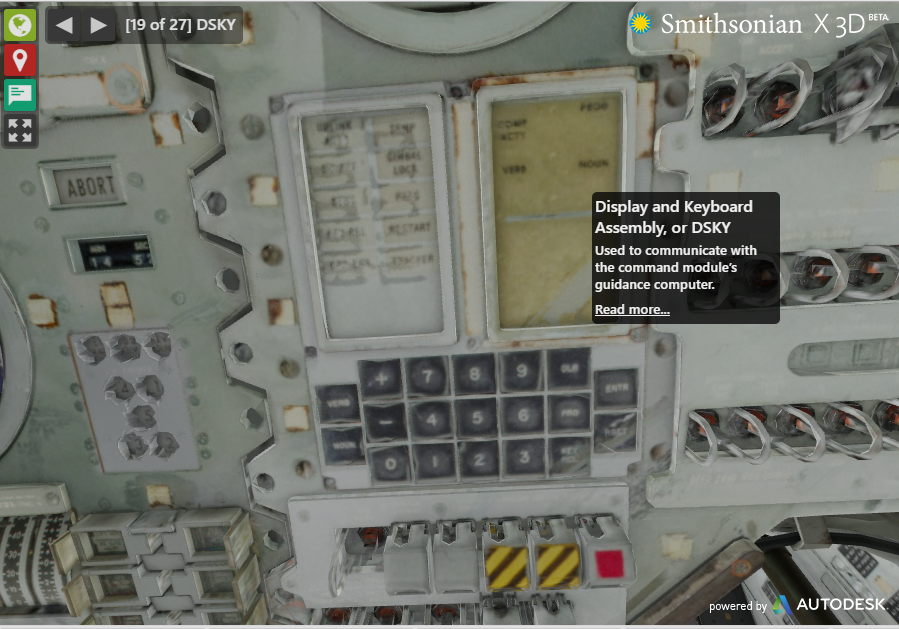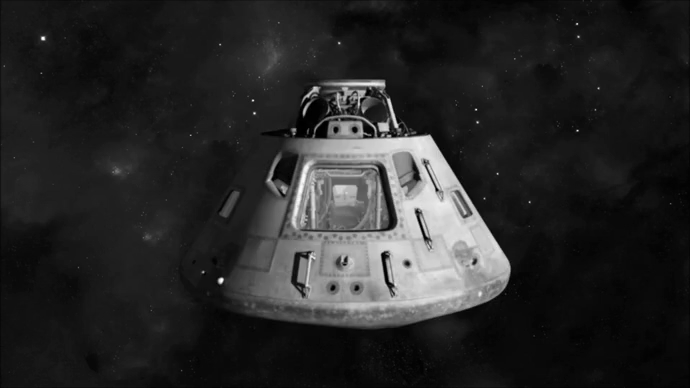3D Model Produced by Autodesk and the Smithsonian Institution Lets You See Inside Apollo 11’s Command Module
 While the moon was officially full last night, it will still appear full, round and bright this evening – almost as though it were celebrating the 47th anniversary of the first moon landing. It was July 20, 1969 that the Apollo 11 touched down on the moon’s surface while the rest of the world watched – and today, you can mark that anniversary by looking inside the Apollo 11’s command module, Columbia.
While the moon was officially full last night, it will still appear full, round and bright this evening – almost as though it were celebrating the 47th anniversary of the first moon landing. It was July 20, 1969 that the Apollo 11 touched down on the moon’s surface while the rest of the world watched – and today, you can mark that anniversary by looking inside the Apollo 11’s command module, Columbia.
Until last year, the Columbia was protected by a sheet of Plexiglass in the Smithsonian National Air and Space Museum, where it has been sitting since the museum opened in 1976. But in December 2015, the Plexiglass was carefully removed so that Adam Metallo and Vince Rossi, 3D digitization program officers at the Smithsonian Institution, could scan the entire thing, inside and out. Over the next two weeks, they utilized six different capture methods and over $1.4 million worth of equipment to obtain meticulously detailed images of the module.
Because they weren’t allowed to climb inside or even touch the module, scanning it was challenging work that the team circumvented by attaching cameras and laser scanners to mechanical arms which were carefully inserted into the module. They were determined not to miss a single tiny detail.
“That’s integral to the story that we want to tell by scanning this object: what it’s like in there,” Metallo said. “We can see the conditions that these astronauts went through and lived with. By scanning the interior with such fidelity and expressing that in 3D models online and potentially in virtual reality, we’re going to be able to give the public a really profound experience and understanding of the object.”
And that’s exactly what the public will get. In honor of the anniversary of the moon landing, the scan data collected by the Smithsonian has been released online in the form of an incredible 3D model that lets viewers see exactly what astronauts Neil Armstrong, Edwin “Buzz” Aldrin and Michael Collins saw during their journey to the moon.
 Go look at it, right now. You can see everything, from control panels to crew couches. You can even read notes scribbled on the walls, including calendars, coordinates, and a warning to crew members to stay away from a particularly “smelly” area of the craft. The detail is amazing – you can actually read the tiny print on parts of the control panel. You could spend hours wandering around in there, and all you need is an Internet connection – although the model does include publicly available data files that can be 3D printed or viewed with a virtual reality headset.
Go look at it, right now. You can see everything, from control panels to crew couches. You can even read notes scribbled on the walls, including calendars, coordinates, and a warning to crew members to stay away from a particularly “smelly” area of the craft. The detail is amazing – you can actually read the tiny print on parts of the control panel. You could spend hours wandering around in there, and all you need is an Internet connection – although the model does include publicly available data files that can be 3D printed or viewed with a virtual reality headset.
The data gathered by the Smithsonian included about 50 laser scans and thousands of pictures taken with 5DSR cameras. Once the imaging was complete, collaborators at Autodesk converted it into the 3D model you can now see online. Traditionalists, however, need not worry – the 3D model is in no way intended to replace the module itself, which will be moved the the Air and Space Museum’s new “Destination Moon” gallery, scheduled to open at the end of the decade. One year ago today, on the 46th anniversary of the first lunar landing, it was also announced that Neil Armstrong’s preserved suit will also be present in “Destination Moon”.
“That experience of ‘I actually stood next to the only part of that spacecraft that in 1969 took three astronauts to the vicinity of the moon and two of them to the surface—I stood next to it,’ that iconic feeling of being next to the real thing will be there,” said Allan Needell, curator of the museum’s Apollo collections. “…The artifact is not to be replaced by digital archives. They complement each other.”
Discuss further over in the Apollo 11 3D Model forum at 3DPB.com.
Subscribe to Our Email Newsletter
Stay up-to-date on all the latest news from the 3D printing industry and receive information and offers from third party vendors.
You May Also Like
Further Understanding of 3D Printing Design at ADDITIV Design World
ADDITIV is back once again! This time, the virtual platform for additive manufacturing will be holding the first-ever edition of ADDITIV Design World on May 23rd from 9:00 AM –...
3D Printer Maker EVO-tech Reborn as NEVO3D — Once More With Feeling
EVO-tech was a 3D printing service and original equipment manufacturer established in 2013 and based in Schörfling am Attersee, Austria. The company produced high-quality material extrusion systems featuring linear bearings,...
3D Systems Brings 3D Printed PEEK Cranial Implant to the U.S. with FDA Clearance
For more than 10 years, 3D Systems (NYSE:DDD) has worked hand-in-hand with surgeons to plan over 150,000 patient-specific cases, and develop more than two million instruments and implants from its...
CDFAM Returns to Berlin for Second Annual Symposium
The second CDFAM Computational Design Symposium is scheduled for May 7-8, 2024, in Berlin, and will convene leading experts in computational design across all scales. Building upon the first event...
































